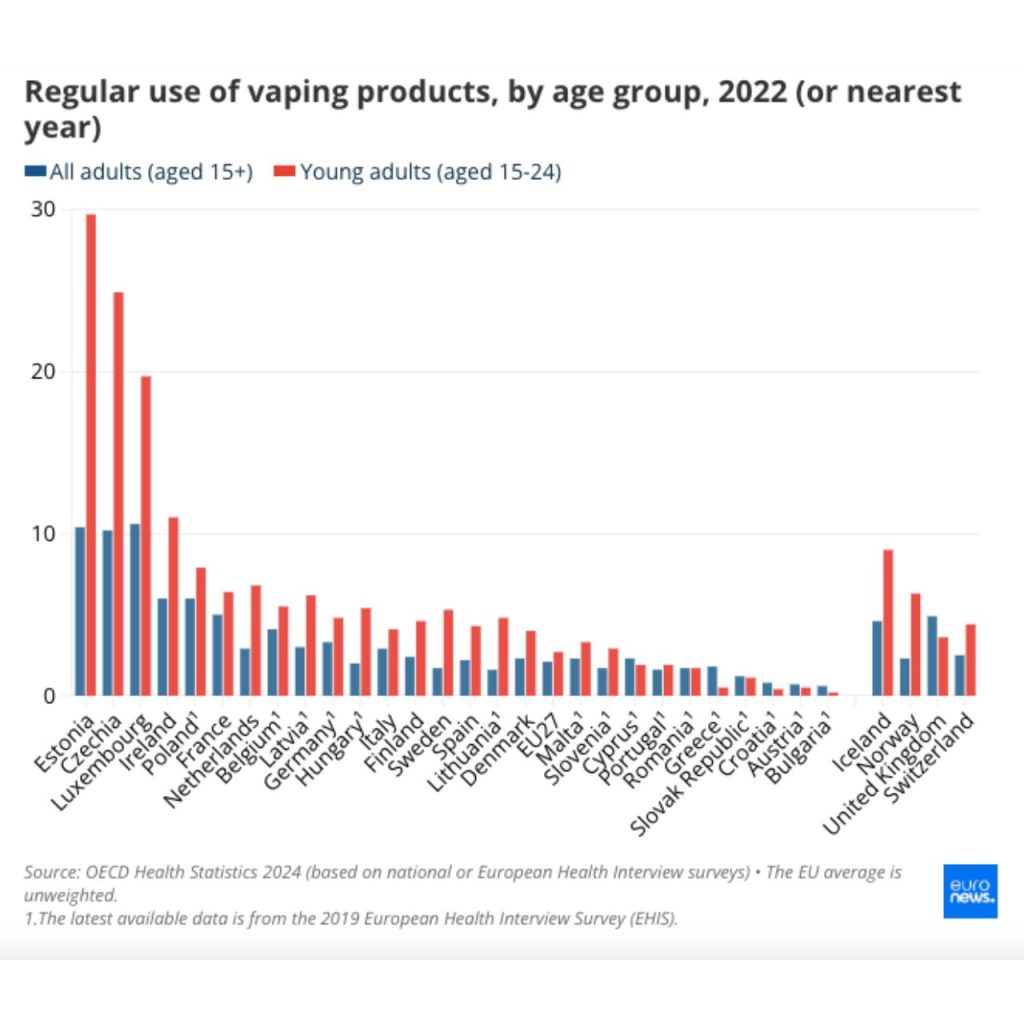As Belgium became the first EU country to ban disposable vejps and several others are in the early stages of similar bans, the OECD has taken a closer look at e-cigarette trends in Europe.
And use among the population varies widely.
With stricter regulations for both cigarettes and smokeless nicotine products underway in different parts of the EU, the use of vejp products continues to grow in European countries. Statistics produced by the Organisation for Economic Co-operation and Development (OECD) show how e-cigarettes are growing in popularity, but also that their use varies greatly between countries. The OECD is an international organisation with 38 member countries, whose main work is economic analysis, assessment and forecasting.
Largest share in Eastern Europe
According to OECD statistics, Estonia, the Czech Republic and Luxembourg have the highest proportion of vejp users in the EU, with over 10 % of the population using e-cigarettes. Among young people aged 15 to 24, use is even higher. Around 30% of young people in Estonia and 25% in the Czech Republic used vejp, compared to the EU average of 6.5%.
The surge in vaping among young people in these countries has simultaneously led to a significant decline in traditional tobacco smoking, according to the report.

Figures a few years old
However, the statistics are based on data reported in 2022, and it should be borne in mind that the world of vejp and nicotine fluctuates rapidly. While the UK is no longer an EU country, it is still included in the statistics as a 'neighbouring country'. According to OECD statistics, 4.9 per cent of adults in the UK vejp - but as Vejpkollen told us the other week, e-cigarettes are on the rise, at least in London, and according to the Office for National Statistics, the figure for the country is closer to 10 per cent.
Whether the gap is due to the difference in survey years or that someone is simply wrong is left unsaid. But statistics are statistics and must be taken with the necessary pinch of salt.
Young vejpaking significantly more
At the bottom of the statistics are Bulgaria, Austria and Croatia, all of which have less than one per cent using vejp. Sweden is roughly in the middle of the OECD graph with reported vejp users at 1.7 per cent. What may distinguish us is a rather large age gap as the group of "young adults" between 15 and 24 years is significantly higher. In this group, 5.3 per cent of Swedes use e-cigarettes.
Young people overall vejpar significantly more in all countries, the statistics show. In Estonia, which has the highest number of vejp users overall at 10.4%, as many as 29.7% of young people are reported to inhale vapour regularly.





I'm curious to know if there were as many young people who used to wire before the disposable wire came out on the market. What you see today when you go into a "minilivs" is a whole stand ugly with all kinds of cool names. Most are on 20mg nicotine that does not feel the slightest, probably high sweetner content is my guess. They taste great but it feels like the product is aimed at the younger audience. And from an environmental point of view, it contains batteries, circuit boards, plastic, and foam rubber. How do you sort it without any information on what to do with it or what it contains? When I started waving about 12-15 years ago, there was a pen model that you bought 10ml bottles in different strengths (the tax was not near as now). Then you refilled these pens that were not of the best quality, above all they had the ability to stop working and leaks were not uncommon. What was marketed in the "mini life" then that was interesting was 10ml bottles that were displayed in the store. The thing is, nicotine is so addictive and these are trends that are particularly important for young people. At the same time, the government is strangling vaping with various proposals. At the same time as disposable vaping is only growing. Taxes have skyrocketed, which is reflected in all these purely physical stores closing one by one. And the online stores are like night and day when it comes to the range of all hardware products, I'm thinking of mods, tanks, etc. And so many online stores that have been bought by larger European companies. It's a bit sad but inevitable given the tax pressure. If you look at an English pure tape store that sells online, then you recognise what it was like on the Swedish tape market before the rules and taxation came. But there are several who are struggling and it is they who should be favoured.